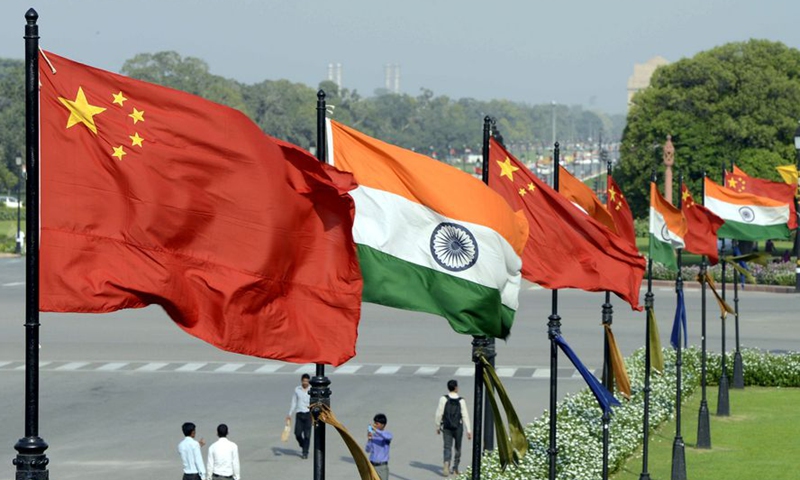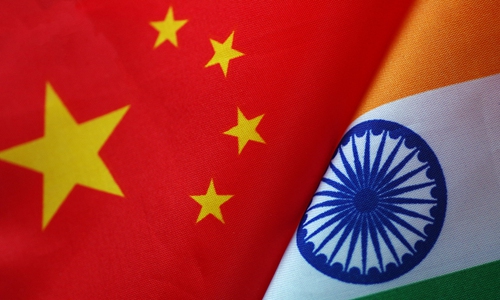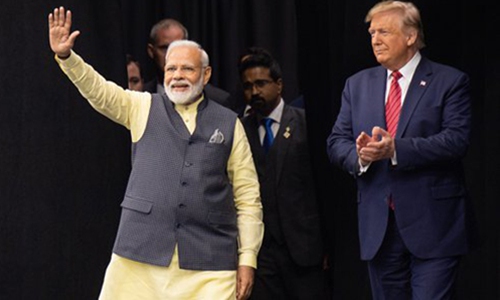China-India border meeting injects hopes to ease tension; ‘bottom line’ with India non-negotiable: experts

File photo:Xinhua
Indian news portal ThePrint.in, citing sources familiar with the matter, reported that the 14 Corps Commander Lieutenant General Harinder Singh and China's Southern Xinjiang Military District chief will attend the meeting.
There are no further updates on the details concerning the meeting, as of press time.
However, ahead of Saturday's scheduled meeting between the military officials, near the site of their border stand-off, India's ministry of external affairs issued a statement on Friday, stressing diplomatic channels as a way to peacefully resolve the border tension in the Ladakh region.
Citing the statement in a late Friday report, the Reuters revealed that senior officials of the two counties held a video conference and reached agreements that two sides should handle their differences through peaceful discussion and not allow the differences degrade into disputes.
Chinese analysts reached by the Global Times on Saturday echoed similar views, agreeing that the peaceful discussion through the diplomatic channel is the only effective way to resolve the problems.
However, Chinese analysts also emphasized that the Indian side should immediately stop provocative acts along the border and respect China's bottom line stance on the common border, otherwise deadlock will not be truly resolved.
They also cautioned that the seemingly friendly rhetoric the Indian side deliberately revealed to the Western media could also serve as a pressure tactic against China, aiming to silence China's reasonable proposition on the pretext of peaceful resolution.
"The due meeting of military generals from the two sides near the site would be conducted in a restrained fashion. But the Indian military must halt any constructing defense facilities across the border into Chinese territory in the Galwan Valley region, and stop crossing the border to create conflicts, which allows no wiggling room and is the fundamental sincerity the Indian side has to offer, " Song Zhongping, a military expert and TV commentator, told the Global Times on Saturday.
Song said the selection of military officials as part of the delegation for the Saturday meeting indicated that the two sides are expected to work together to resolve the regional tension in a point-to-point manner.
Top tactical army commanders stationed near the site are sufficient to raise relevant issues and implement the outcome of the discussions within the region. However, any major China-India border disputes, bigger than the current round of tensions, may require participants at the level of the defense and foreign ministries, Song said.
Chinese border defense troops have bolstered border control measures and made necessary moves in response to India's recent, illegal construction of defense facilities across the border into Chinese territory in the Galwan Valley region, a source close to Chinese military told the Global Times in May.
Since early May, India has been crossing the boundary line in the Galwan Valley region and entering Chinese territory. The Indian side built defense fortifications and created obstacles to disrupt Chinese border defense troops' normal patrol activities, purposefully instigated conflicts, and attempted to unilaterally change the current border control situation, the military source said.
This round of China-India border tension is reminiscent of the 2017 Doklam stalemate.
"At present, the overall situation in the China-India border areas is stable and controllable," said Chinese Foreign Ministry spokesperson Geng Shuang, at a routine press conference on Friday.
Geng added, "There are sound mechanisms for border-related matters between China and India. The two sides maintain close communication through diplomatic and military channels and are working to properly resolve relevant issues."
China's stance at the border is consistent, which adheres to the principle of not initiating troubles and safeguarding the peace and stability at the border region, said Hu Zhiyong, a research fellow at the Institute of International Relations of the Shanghai Academy of Social Sciences.
"The Indian side might have miscalculated the situation, and tried to press China to make compromise by creating troubles amid the COVID-19 pandemic," Hu told the Global Times on Saturday.
The Indian side should now understand that border disputes can only be resolved in good faith from both sides, rather than exerting pressure on the other side when encountering difficulties, Hu noted. "India has clearly underestimated China's capability to cope with the COVID epidemic in the country."
Indian officials said both sides would first focus on getting both the Indian army and the People's Liberation Army to pull back additional troops and equipment deployed in the area, according to the Reuters report.
Chinese observers predict that the military of the two countries, after Saturday's high-level meeting, will cease operations "to certain extent," but the border tension may continue, mainly due to India's tendency of playing petty tricks on the border.
However, there is still a possibility that India would adopt a hard-line stance during the military meeting, as a way of shifting focus from its domestic difficulties of containing the COVID-19, Zhao Gancheng, a research fellow at the Shanghai Institute for International Studies, told the Global Times on Saturday.
China should be prepared for further escalating tension, and China does not fear such an outcome, Zhao said.
Chinese and Indian leaders held an informal summit in 2018 and reached an important consensus. The high-ranking officials of both countries maintained frequent contacts over the past two years, and Indian leaders showed strategic calmness.



